Reagent From KFU “Lightened” Heavy Oil Directly in the Reservoir
The third injection of aquathermolysis catalyst was carried out for RITEK in the Samara Region.
Scientists from the Institute of Geology and Petroleum Technologies (IGiNT) of Kazan Federal University conducted the third injection of the UniKat oil aquathermolysis catalyst at a field in the Samara Region. The news agency “Devon” learned about this from the message of the Kazan Federal University.
The catalyst for the in-situ conversion of heavy oil, developed at the Catalytic Aquathermolysis Research Laboratory, allows oil to be upgraded directly in the reservoir, reducing the viscosity and content of high-molecular heteroorganic compounds, increasing the amount of light components, as well as oil flow rate and oil recovery factor.
Previously, a catalyst precursor was injected at the same field. The results of the observation showed the high efficiency of the reagent and made it possible to recommend it for further implementation in heavy oil fields.
In October 2022 and August 2023, RITEK commissioned pilot testing of a catalyst precursor for the Strelovsky high-viscosity oil field in the Samara Region. The technology of in-situ oil upgrading by the method of catalytic aquathermolysis, developed by scientists of the World-Class Scientific Center (NTsMU) “Rational development of the planet’s liquid hydrocarbon reserves”, has been successfully introduced in this territory.
“Aquathermolysis catalysts function in the porous medium of the reservoir rock, intensifying the processes of destruction of high-molecular components in the composition of oil,” said Alexei Vakhin, head of the Catalytic Aquathermolysis Research Laboratory. “This provides an increase in the mobility of oil, increases oil recovery and provides a decrease in the viscosity of the produced oil.”
The next batch of catalyst and solvent was produced in volumes of 4.5 and 6 tons, respectively. According to Irek Mukhamatdinov, senior researcher at the Research Laboratory for Enhanced Oil Recovery Methods, the composition of the catalyst was selected based on the results of laboratory studies.
As a result, it was found that catalysts significantly increase the flow rate of an oil well, reduce the steam-to-oil ratio, improve the physico-chemical properties of “black gold”, and reduce viscosity and density.
“Five days after the catalyst is injected, superheated steam is injected, the well is working using CSS technology,” said Sergey Malaniy, Lead Engineer of the Innovative Technologies and Strategic Projects Department of LUKOIL-Engineering LLC.
IA Devon reported that the catalysts developed at Kazan University were previously introduced at the Boca de Jaruco fields in Cuba and Ashalchinskoye in Tatarstan.
The world’s first monograph on catalytic underground oil upgrading was published at KFU.











